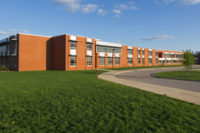Four Keys to Securing K-12 Campus Entries

The challenges of keeping inappropriate people out of a K-12 school have led many campus administrators to rethink how they control building entries. Unwanted visitors ranging from a non-custodial parent to an active shooter have too often entered a school through an easily accessible door. However, there are steps security experts agree can prevent – or at least delay – entry, making both students and teachers safer.
Here’s a look at four proven best practices for controlling campus visitors.
Doors
Most school buildings have multiple entries. Some schools have 20 or more doors. Glass doors, popular on many campuses, offer less protection than solid-core wood or metal doors. If replacing glass doors is impractical because of architectural or other reasons, apply stainless steel mesh screens or security film to the glass. Either will at least delay criminals using a gun or blunt instrument from shooting or smashing their way into the building. The cost of applying security film ranges between $8 and $10 per square foot.
Keep doors locked. Unfortunately, the days of wide-open, easy-access schools have long passed. Electric strike locks with a “fail-safe, fail-secure” standard, meaning they remain locked on the outside even during a power failure, are the best choice. One benefit of electric strike doors is their ability to be remotely locked and unlocked. Don’t forget to add a strike latch guard to protect against tampering.
Designate one door for faculty and staff. Adding a card reader or keypad, linked to even a base access control system, provides a secure entry for employees. Designate another door for students, one that will be open 30 minutes prior to and after class hours. Station a student resource officer (SRO) at the door and ask local first responders for added patrols during these times.
Tardy students or staff members who forget their access cards can use a visitor entry. This door should have direct access to the school office. Again, keep the door locked unless an approved visitor is entering. Post signage in the parking lot and around the campus making it clear which door is for visitors.
Video Intercom
A video intercom is key here. Visitors push the “Call” button on a door station to reach a master station in the office. From there, staff can see visitors, and conduct a two-way conversation before deciding to remotely open the door. If there’s any doubt about a visitor’s intentions, the door should stay closed and locked.
The embedded camera in a video intercom helps eliminate “piggybacking” – an event where unannounced guests attempt to enter along with an approved visitor. Camera video can also be recorded for forensic review. Intercoms are also useful when placed near other doors, such as at delivery bays.
Students or visitors can use intercoms to directly contact the office in case of an emergency. IP-based units connected to the campus network may be monitored in a district security operations center (SOC), allowing security officers to remotely open doors for community organizations using a school facility after hours. Smartphone and tablet apps let patrolling SROs or security officers monitor and maintain control of the intercoms.
Vestibule
A vestibule, often referred to as a mantrap, is a more expensive, yet valuable, addition to a secured entry. It provides one last locked barrier between a visitor and students. Many architects now include mantraps in the design of new schools. Other campuses are retrofitting main entries to include vestibules. This involves building another wall or two, adding a door with another electric strike lock, and a bulletproof glass window with pass-through opening – much like you’d find at a bank teller’s station. The window enables office staff to confirm only authorized visitors entered and look for weapons or other contraband. And the pass-through slot provides one more visitor check.
Visitor Management
Once inside the vestibule, visitors should produce a government-issued identification card for the office staff to swipe through a visitor management system. The card’s data is compared with online federal and local criminal databases, and sex offender registries. Local watch lists can be created. If cleared, the system prints an adhesive ID badge to be worn while the visitor is on the campus. At this point, the door into the main facility can be unlocked. An added benefit of a visitor management system is that staff knows how many visitors are on campus in case of an emergency requiring evacuation.
These are four physical security assets to consider when hardening a K-12 campus entry. But don’t forget the development of written entry policies and procedures. Staff members need training to spot potential behaviors, and other signs of potentially dangerous visitors. Students should understand they are not to open doors to anyone requesting entry.
With proper planning and the use of these best practices, it’s possible to control visitors and create a safer, more secure K-12 campus.
Looking for a reprint of this article?
From high-res PDFs to custom plaques, order your copy today!





